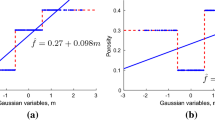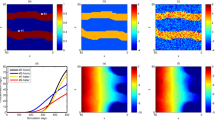Abstract
The truncated pluri-Gaussian model is a powerful tool for representing realistic spatial distributions of facies in reservoir characterization. It is suitable for generating stochastic three-dimensional facies realizations with complex vertical and lateral relationships such as are observed in algal mound behavior. Truncated pluri-Gaussian realizations account for anisotropies and relative proportions of the facies. Despite their advantages, truncated pluri-Gaussian models have not been extensively used in data assimilation techniques such as ensemble-Kalman-based algorithms. One of the major limitations encountered in the existing implementations is the difficulty of preserving facies observations at well locations through the data assimilation procedure arising even for weakly correlated data. In this work, the problem of maintaining consistency of realizations with facies is solved by merging the data assimilation algorithm (Levenberg–Marquardt ensemble randomized maximum likelihood) with an interior-point method suitable of inequality constraints. The iterative ensemble smoother is effective at assimilating highly nonlinear production data, while the interior-point method takes into account the inequality constraints on the Gaussian model variables during the data assimilation. The formulation uses an objective function that includes a model-mismatch term, a data-mismatch term and a boundary penalization function. The method allows for its approximate version neglecting model-mismatch. The algorithm was tested on a three-dimensional synthetic reservoir mimicking the algal mounds shapes of an outcrop in the Paradox Basin of Utah and includes a large number of strongly correlated facies data and significant change of petrophysical properties for different facies. It resulted in good decrease in the data-mismatch while preserving the mound structure realism and variability in the ensemble.














Similar content being viewed by others
References
Agbalaka CC, Oliver DS (2008) Application of the EnKF and localization to automatic history matching of facies distribution and production data. Math Geosci 40(4):353–374
Armstrong M, Galli A, Beucher H, Le Loc’h G, Renard D, Doligez B, Eschard R, Geffroy F (2011) Plurigaussian simulation in geoscience, 2nd edn. Springer, Berlin, Heidelberg
Bell BM, Burke JV, Pillonetto G (2009) An inequality constrained nonlinear Kalman–Bucy smoother by interior point likelihood maximization. Automatica 45(1):25–33
Cardiff M, Kitanidis PK (2009) Bayesian inversion for facies detection: an extensible level set framework. Water Resour Res 45(10):W10416. doi:10.1029/2008WR007675
Chang H, Chen Y, Zhang D (2010) Data assimilation of coupled fluid flow and geomechanics using ensemble Kalman filter (SPE 118963). SPE J 15(2):382–394
Chen Y, Oliver DS (2013) Levenberg–Marquardt forms of the iterative ensemble smoother for efficient history matching and uncertainty quantification. Comput Geosci 17(4):689–703
Dorn O, Villegas R (2008) History matching of petroleum reservoirs using a level set technique. Inverse Probl 24(3):035015
Dovera L, Della Rossa E (2011) Multimodal ensemble Kalman filtering using gaussian mixture models. Comput Geosci 15:307–323
Emerick AA, Reynolds AC (2013) Investigation of the sampling performance of ensemble-based methods with a simple reservoir model. Comput Geosci 17(2):325–350
Emery X (2007) Simulation of geological domains using the plurigaussian model: new developments and computer programs. Comput Geosci 33(9):1189–1201
Evensen G (1994) Sequential data assimilation with a nonlinear quasi-geostrophic model using Monte Carlo methods to forecast error statistics. J Geophys Res 99(C5):10143–10162
Falivene O, Cabrera L, Mu noz JA, Arbués P, Fernández O, Sáez A (2007) Statistical grid-based facies reconstruction and modelling for sedimentary bodies. alluvial-palustrine and turbiditic examples. Geologica Acta 5(3):199–230
Franssen HJH, Alcolea A, Riva M, Bakr M, van der Wiel N, Stauffer F, Guadagnini A (2009) A comparison of seven methods for the inverse modelling of groundwater flow. Application to the characterisation of well catchments. Adv Water Resour 32(6):851–872
Galli A, Le Loc’h, G, Geffroy F, Eschard R (2006) An application of the truncated pluri-gaussian method for modeling geology. In: Coburn TC, Yarus JM, Chambers, RI (eds) Stochastic modeling and geostatistics: principles, methods, and case studies, vol II. AAPG Comput Appl Geol, pp 109–122
Gentilhomme T, Oliver DS, Caumon G, Moyen R (2012) Smooth multi-scale parameterization for integration of seismic and production data using second-generation wavelets. In: 13th European conference on the mathematics of oil recovery, 10–13 Sept 2012, Biarritz
Hu LY, Zhao Y, Liu Y, Scheepens C, Bouchard A (2013) Updating multipoint simulations using the ensemble Kalman filter. Comput Geosci 51:7–15
Jafarpour B (2011) Wavelet reconstruction of geologic facies from nonlinear dynamic flow measurements. Geosci Remote Sens 49(5):1520–1535
Jafarpour B, Khodabakhshi M (2011) A probability conditioning method (PCM) for nonlinear flow data integration into multipoint statistical facies simulation. Math Geosci 43:133–164
Jafarpour B, McLaughlin DB (2009) Reservoir characterization with the discrete Cosine transform. SPE J 14(1):182–201
Khodabakhshi M, Jafarpour B (2013) A bayesian mixture-modeling approach for flow-conditioned multiple-point statistical facies simulation from uncertain training images. Water Resour Res 49(1):328–342
Le Loc’h G, Galli A (1997) Truncated plurigaussian method: Theoretical and practical points of view. In: Baafi EY, Schofield NA (eds) Geostatistics, vol 1. Wollongong ’96, Kluwer Acad., pp 211–222
Lien M, Berre I, Mannseth T (2005) Combined adaptive multiscale and level-set parameter estimation. Multiscale Model Simul 4(4):1349–1372
Liu N, Oliver DS (2004) Automatic history matching of geologic facies. SPE J 9(4):188–195
Liu N, Oliver DS (2005) Ensemble Kalman filter for automatic history matching of geologic facies. J Pet Sci Eng 47(3–4):147–161
Liu Y (2006) Using the Snesim program for multiple-point statistical simulation. Comput Geosci 32(10):1544–1563
Liu Y, Gupta HV (2007) Uncertainty in hydrologic modeling: toward an integrated data assimilation framework. Water Resour Res 43(7):W07401. doi:10.1029/2006WR005756
Lorentzen RJ, Nævdal G, Shafieirad A (2011) Estimating facies field using the ensemble Kalman filter and distance function-applied to shallow-marine environment, SPE-143031. In: SPE EUROPEC/EAGE annual conference and exhibition, 23–25 May 2011, Vienna
Mariethoz G, Renard P, Cornaton F, Jaquet O (2009) Truncated plurigaussian simulations to characterize aquifer heterogeneity. Ground Water 47(1):13–24
Moreno D, Aanonsen SI (2007) Stochastic facies modeling using the level set method. In: Petrolium Geostatistics 2007, 10–14 Sept 2007, Cascais. A18. Utrecht: Ext. Abstracts Book, EAGE Publ. B.V
Nielsen LK, Tai X-C, Aanonsen SI, Espedal M (2007) Reservoir description using a binary level set approach with additional prior information about the reservoir model. In: Tai X-C, Lie K-A, Chan TF, Osher S (eds) Image processing based on partial differential equations, mathematical and visualization. Springer, Berlin, Heidelberg, pp 403–426
Oliver DS, Chen Y (2011) Recent progress on reservoir history matching: a review. Comput Geosci 15(1):185–221
Oliver DS, He N, Reynolds AC (1996) Conditioning permeability fields to pressure data. In: 5th European conference for the mathematics of oil recovery, pp 1–11
Osher S, Sethian JA (1988) Fronts propagating with curvature dependent speed: algorithms based on hamilton-jacobi formulations. J Comput Phys 79(1):12–49
Phale HA, Oliver DS (2011) Interior point formulation for the constrained ensemble Kalman filter (SPE 141798). In: SPE reservoir simulation Symposium, 21–23 Feb 2011, The Woodlands
Sarma P, Chen W (2009) Generalization of the ensemble Kalman filter using kernels for non-gaussian random fields, SPE-119177. In: SPE reservoir simulation symposium, 2–4 Feb 2009, The Woodlands
Sarma P, Durlofsky LJ, Aziz K (2008) Kernel principal component analysis for efficient, differentiable parameterization of multipoint geostatistics. Math Geosci 40(1):3–32
Strebelle S (2002) Conditional simulation of complex geological structures using multiple-point statistics. Math Geol 34(1):1–21
Tarantola A (2005) Inverse problem theory and methods for model parameter estimation. Society for industrial and applied mathematics, Philadelphia, p 75-80
Vabø J, Evensen G, Hove J, Skjervheim JA (2008) Using the EnKF with kernel methods for estimation of non-Gaussian variables. In: 11th European conference on the mathematics of oil recovery, 8–11 Sept 2008, Bergen
Villegas R, Dorn O, Moscoso M, Kindelan M (2006) Simultaneous characterization of geological regions and parameterized internal permeability profiles in history matching. In: Proceedings of the 10th European conference on the mathematics of oil recovery, Amsterdam, p A015
Zhang F, Reynolds AC, Oliver DS (2003) The impact of upscaling errors on conditioning a stochastic channel to pressure data. SPE J 8(1):13–21
Zhao Y, Reynolds AC, Li G (2008) Generating facies maps by assimilating production data and seismic data with the ensemble Kalman filter, SPE-113990. In: Proceedings of the 2008 SPE improve. Oil recovery symposium, Tulsa, April 21–23 2008
Zhou H, Gómez-Hernández JJ, Franssen H-JH, Li L (2011) An approach to handling non-Gaussianity of parameters and state variables in ensemble Kalman filtering. Adv Water Resour 34(7):844–864
Acknowledgments
Funding for the project Reservoir Data Assimilation For Realistic Geology was provided by industry partners ConocoPhillips, Eni, Petrobras, Statoil, and Total, as well as the Research Council of Norway (PETROMAKS). Eclipse academic licenses are provided by Schlumberger.
Author information
Authors and Affiliations
Corresponding author
Appendices
Appendix A: Barrier Function Derivatives
To compute the model update at each iteration, one needs to evaluate the derivatives and the Hessian of \(\hat{S}(m)\) [Eq. (3)]
Thus the first and the second order partial derivatives of \( f_\mathrm{b}(m)\) [Eq. (5)] are developed as
If \(c_\alpha (m) = (m_{\text {max,}\alpha } - (m)_{\alpha })( (m)_{\alpha } - m_{\text {min,}\alpha })\), then
For the two linear forms of \(c_\alpha (m)\)
Note that \(\frac{\partial ^2 f_\mathrm{b}}{\partial \mathbf {m}^2} ({\mathbf {m}_n}) \) is a diagonal matrix, because for \(\alpha \ne \beta \)
Appendix B: Update Direction Implementation
The formula for the model update [Eq. (14)] with the interior-point penalty can be derived as follows
Rights and permissions
About this article
Cite this article
Astrakova, A., Oliver, D.S. Conditioning Truncated Pluri-Gaussian Models to Facies Observations in Ensemble-Kalman-Based Data Assimilation. Math Geosci 47, 345–367 (2015). https://doi.org/10.1007/s11004-014-9532-3
Received:
Accepted:
Published:
Issue Date:
DOI: https://doi.org/10.1007/s11004-014-9532-3




